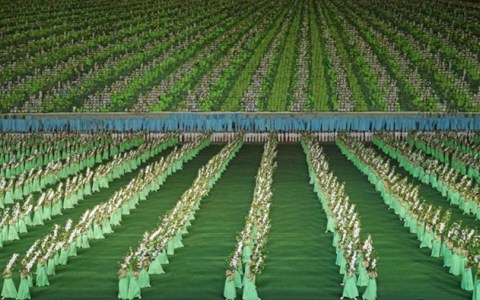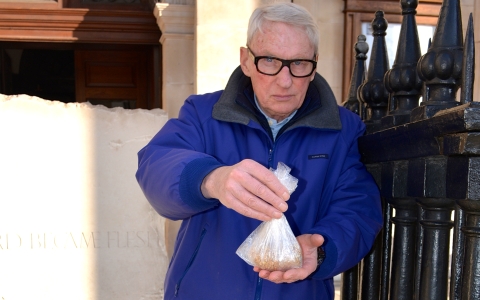The Art of Propaganda in a Nation of No Religion
by - 6th February 2015

The small plastic bag contains 500 grammes of corn. Former television reporter Jeremy Hunter carries it around with him. It reminds him of what the people of North Korea have to endure.
Jeremy Hunter chronicles festivals and celebrations around the world. Many have more than an element of religion to them.
His series of exhibitions and talks, starting this month in Norwich, reveal a celebration that is arguably among the most intricate and godless of them all, the Arirang festival in North Korea.
Propaganda
The propaganda art festival is drawn from a legend shared by both south and north of an impossible love story across the divide. It is a metaphor for separation.
‘Arirang,’ said Hunter, ‘is the name of the most famous song in Korea. It is about a young couple in love. He’s from the north, she’s from the south. Arirang is enormous celebration, to promote the history of North Korea as seen through the regime and to illustrate the history of the workers’ party.’
Hunter began his media career in advertising - as a creative and television producer, working for some of the UK's and USA's top advertising agencies.
Over the past thirty years he has divided his media activities between television and photojournalism. His special interest in documenting the world’s festivals, rituals, ceremonies and celebrations has taken him to 65 countries across five continents.
Hunter has received three UNESCO awards and is a Fellow of the Royal Geographical Society, London. His books include Sacred Festivals (MQP, London) and Let’s Celebrate - Myth and Narrative (telefoto).
He has also picked up top photographic awards from the Sunday Telegraph and BBC.
In 2011 Hunter managed to get a visa to North Korea via Beijing and was able to photograph the Arirang festival. His pictures disclose an extraordinary mass celebration combining games, gymnastics and dance with mosaics created by 30,000 schoolchildren holding flip charts.
Lie
On the eve of the opening of his exhibition in Norwich, Hunter described the North Korean state as built on a ‘lie’ indoctrinated into the population of nearly 25 million. They are raised to believe their country is utopia, the envy of the world and the best place of all to live.
The late Kim-Il Sung claimed to come from a Christian background. He is reported to have said he was the grandson of a Protestant minister and that his father was an elder in the Presbyterian Church.
But when the country was divided in 1945 most Christians fled to the south.
The north became an atheist state, and although some Christians survive and meet secretly, they are at constant risk of being sent to one of the six feared political prison camps or one of up to 20 re-education camps.
‘The only thing to remember is there is no [permitted] religion in North Korea,’ said Hunter. ‘There are practising Christians there but it is done under cover and in extreme secrecy.’
1984
In the book that accompanies Hunter’s exhibition and talks, he compares the Democratic People’s Republic of Korea to Orwell’s fictional state in the novel 1984. It was published in 1948 – the year Kim Il-Sung came to power.
Hunter wrote: ‘Orwell could not possibly have imagined that [his] fictional state, Oceania, could replicate life as it is lived today in North Korea: the basic housing, lack of food, constant surveillance by the State, and above all, the need to demonstrate total loyalty and commitment to the Party.’
He added: ‘The Democratic People’s Republic of Korea is the world’s only hereditary Stalinist dictatorship. It is also the world’s most secretive and closed society.
‘When travelling through the country, we were always accompanied by two “minders”. When questioned on any subject relating to life and cultural habits of their country, they would answer with the barest minimum of information.’
Although Hunter barely understood what he saw at the time, he said he was moved to research more deeply into the country. His exhibition is to create awareness of what is happening.
Hunger
The small plastic bag of corn? Hunter carries it around as a constant reminder of what hardship and hunger mean to so many.
Although the markets in North Korea are starting to open up, for many years these bags represented the entire daily ration for all but the elite. ‘The corn would normally be used to make soup,’ said Hunter. ‘One bag contains just 1000 calories.
‘If you are loyal to the regime you can lead a reasonable life. You can survive. If you have any thoughts the country you are living in is not the utopia it is promoted as, life can be incredibly hard. I just feel the people of North Korea are entitled to a better life than what they have been suffering since the division of the country in 1945.’

Dates and venues for his illustrated talk: Propaganda and the Cult of the Kim's daily life in the Hermit Kingdom
10 February 2015 7.30pm: Royal Geographical Society, Pierce Room, Assembly House, Theatre Street, Norwich, NR2 1RQ.
11 February 2015 7.30pm: Pleasance Theatre, Carpenters Mews North Road Islington London N7 9EF
2 - 5 March 2015: Royal Scottish Geographical Society, Tour in Scotland - Aberdeen, Dundee, Dunfermline, Edinburgh, Glasgow
